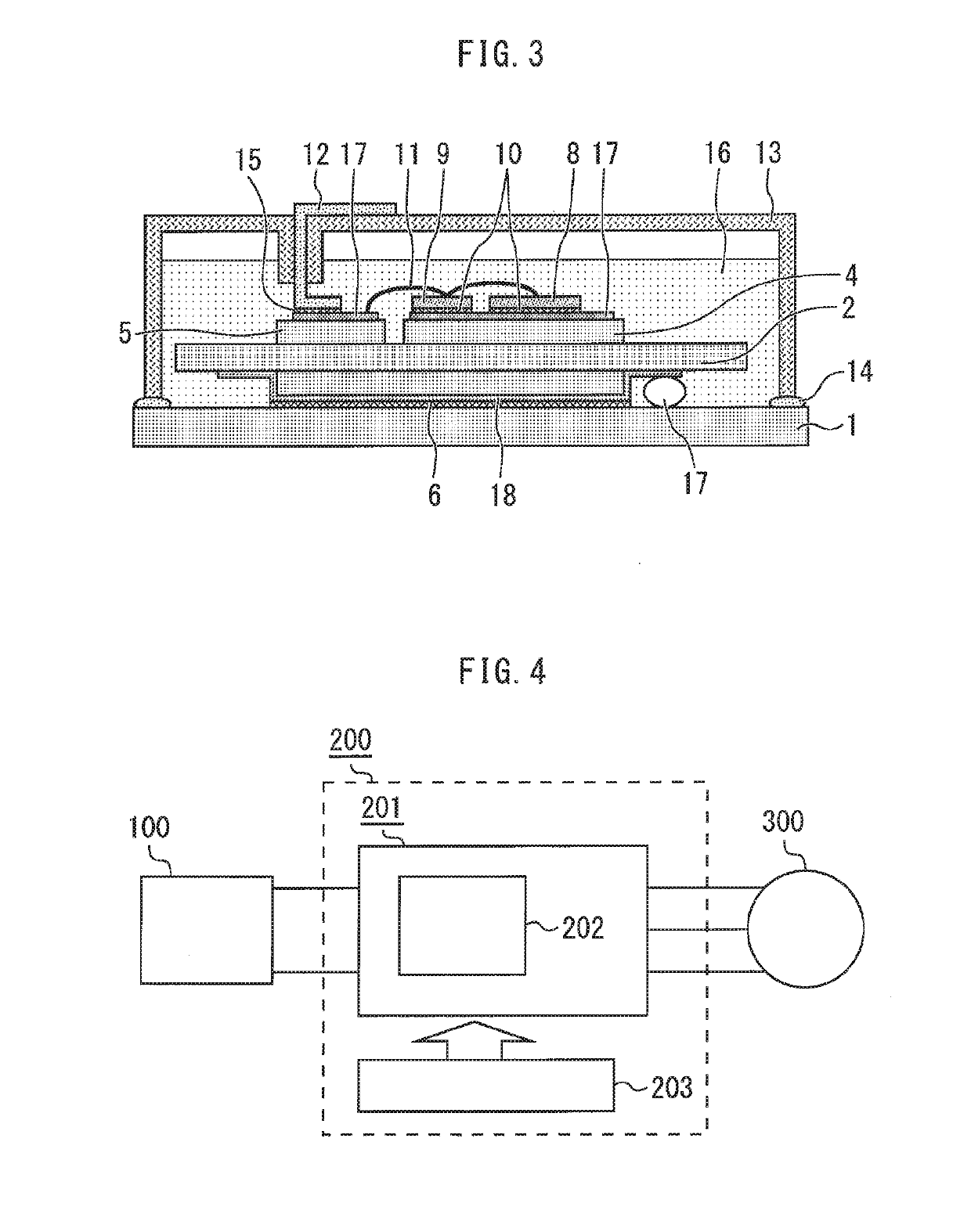Semiconductor module, method for manufacturing the same and power conversion apparatus
- Summary
- Abstract
- Description
- Claims
- Application Information
AI Technical Summary
Benefits of technology
Problems solved by technology
Method used
Image
Examples
first embodiment
[0014]FIG. 1 is a cross-sectional view illustrating a semiconductor module according to a first embodiment. A ceramic substrate 2 is provided on a cooling base plate 1. The ceramic substrate 2 is made of, for example, silicon nitride or aluminum nitride and has a thickness of 200 μm to 1.2 mm.
[0015]An undersurface electrode 3, and top surface electrodes 4 and 5 are bonded to an undersurface and a top surface of the ceramic substrate 2 respectively using a brazing material such as Ag. A desired pattern is formed through a photoengraving process and the top surface electrodes 4 and 5 are patterned through selective etching using an etchant such as an acid. The undersurface electrode 3 and the top surface electrodes 4 and 5 are made of metal such as copper. The undersurface electrode 3 is bonded to the base plate 1 via solder 6. The top surface electrodes 4 and 5 on the substrate top surface need to have a thickness on the order of 200 to 500 μm to allow a high current to flow. The und...
second embodiment
[0026]FIG. 3 is a cross-sectional view illustrating a semiconductor module according to a second embodiment. In order to secure solderability necessary in posterior steps, an electroless nickel plating layer 18 is selectively formed on the surfaces of the undersurface electrode 3 and the top surface electrodes 4 and 5. In that case, the electroless nickel plating layer 18 is also formed on the undersurface of the ceramic substrate 2, and by patterning the electroless nickel plating layer 18, it is possible to form the conductive thin-film 7. In addition, it is possible to obtain effects similar to the effects of the first embodiment.
[0027]Note that the conductive thin-film 7 is not limited to electroless nickel plating, but may be formed using metal such as nickel, tin or solder through an electron beam vapor deposition or sputtering apparatus. In this case, when a work is set in an electron beam vapor deposition apparatus, the conductive thin-film 7 is selectively formed using a ma...
third embodiment
[0034]In this embodiment, the semiconductor modules according to the first or second embodiment described above are applied to an electric power conversion device. The electric power conversion device is, for example, an inverter device, a converter device, a servo amplifier, or a power supply unit. Although the present invention is not limited to a specific electric power conversion device, a case where the present invention is applied to a three-phase inverter will be described below.
[0035]FIG. 4 is a block diagram illustrating a configuration of an electric power conversion system to which the electric power conversion device according to the third embodiment is applied. This electric power conversion system includes a power supply 100, an electric power conversion device 200, and a load 300. The power supply 100 is a DC power supply and supplies DC power to the electric power conversion device 200. The power supply 100 can be composed of various components. For example, the powe...
PUM
 Login to View More
Login to View More Abstract
Description
Claims
Application Information
 Login to View More
Login to View More - R&D
- Intellectual Property
- Life Sciences
- Materials
- Tech Scout
- Unparalleled Data Quality
- Higher Quality Content
- 60% Fewer Hallucinations
Browse by: Latest US Patents, China's latest patents, Technical Efficacy Thesaurus, Application Domain, Technology Topic, Popular Technical Reports.
© 2025 PatSnap. All rights reserved.Legal|Privacy policy|Modern Slavery Act Transparency Statement|Sitemap|About US| Contact US: help@patsnap.com


